Podcast
Questions and Answers
What is the symbol used for conjunctions in logic?
What is the symbol used for conjunctions in logic?
- →
- ∨
- ∧ (correct)
- ↔
Which statement correctly represents the conclusion of the Law of Contrapositive?
Which statement correctly represents the conclusion of the Law of Contrapositive?
- ~p → ~q
- q → p
- p → q
- ¬q → ¬p (correct)
What is the conclusion derived from the following premises: p ∨ q and ~p?
What is the conclusion derived from the following premises: p ∨ q and ~p?
- p ∧ q
- p
- ¬p ∨ q
- q (correct)
In a truth table for conditionals, when is p → q false?
In a truth table for conditionals, when is p → q false?
Which of the following laws states that if p is true, then both p and q must also be true?
Which of the following laws states that if p is true, then both p and q must also be true?
Which law allows us to infer q when we know p → q and p?
Which law allows us to infer q when we know p → q and p?
What is the correct expression for De Morgan's Law applied to the disjunction of two statements?
What is the correct expression for De Morgan's Law applied to the disjunction of two statements?
Which of the following is a characteristic of a tautology in logic?
Which of the following is a characteristic of a tautology in logic?
Flashcards are hidden until you start studying
Study Notes
Logic
-
Introduction to Logic
- Distinction between mathematical and nonmathematical sentences
- Open sentences contain variables; closed sentences do not
-
Negation
- Symbol: ~
-
Conjunctions (And)
- Symbol: ∧
- Truth table:
- T, T → T
- T, F → F
- F, T → F
- F, F → F
-
Disjunctions (Or)
- Symbol: ∨
- Truth table:
- T, T → T
- T, F → T
- F, T → T
- F, F → F
-
Conditionals (If..., then...)
- Symbol: →
- Truth table:
- T, T → T
- T, F → F
- F, T → T
- F, F → T
-
Biconditionals (...if and only if...)
- Symbol: ↔
- Truth table:
- T, T → T
- T, F → F
- F, T → F
- F, F → T
-
Tautology
- A compound statement that is always true
-
Logically Equivalent Statements
- Statements that yield the same truth value in all possible scenarios
-
De Morgan's Laws
- ~(p ∧ q) is equivalent to ~p ∨ ~q
- ~(p ∨ q) is equivalent to ~p ∧ ~q
-
Conditional Statements and Related Forms
- Conditional: p → q
- Converse: q → p
- Inverse: ~p → ~q
- Contrapositive: ~q → ~p
- Conditionals and contrapositives are logically equivalent: (p → q) ↔ (~q → ~p)
-
Law of Contrapositives
- From p → q concludes ~q → ~p
-
Law of Modus Ponens (Detachment)
- Given p → q and p, conclude q
-
Law of Modus Tollens
- Given p → q and ~q, conclude ~p
-
Law of Disjunctive Inference
- Given p ∨ q and ~p, conclude q
- Given p ∨ q and ~q, conclude p
-
Law of Conjunction
- From p and q conclude p ∧ q
-
Law of Simplification
- From p ∧ q, conclude p
- From p ∧ q, conclude q
-
Law of Disjunctive Addition
- From p, conclude p ∨ q
-
Chain Rule (Law of Syllogism)
- From p → q and q → r, conclude p → r
Studying That Suits You
Use AI to generate personalized quizzes and flashcards to suit your learning preferences.




